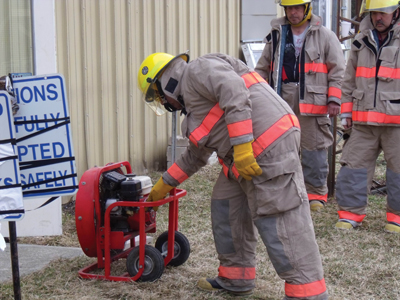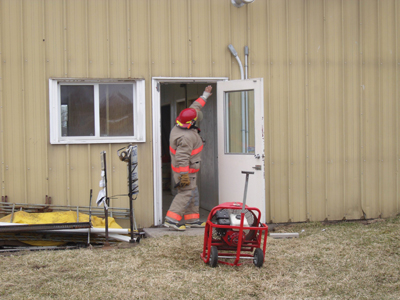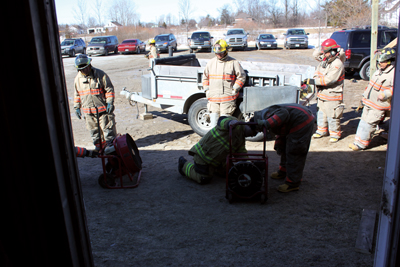
Features
Structural
Training
Back to Basics: June 2011
In the last two issues, we looked at the benefits of vertical ventilation for fire-ground operations and tactics, and we learned how to make a louvred cut. Sometimes, firefighters cannot make it to the roof because of safety concerns. When this is the case, horizontal ventilation is an option.
May 18, 2011
By Mark Van Der Feyst
In the last two issues, we looked at the benefits of vertical ventilation for fire-ground operations and tactics, and we learned how to make a louvred cut. Sometimes, firefighters cannot make it to the roof because of safety concerns. When this is the case, horizontal ventilation is an option.
 |
|
| Photo 1: Firefighters need to be cautious about starting a fan for positive pressure ventilation and be sure to keep dangling straps from a helmet or gear out of the way.
|
The purpose of horizontal ventilation is the same as vertical ventilation: to remove heat, unburned gas and smoke, and replace those elements with fresh air. There are many benefits to horizontal venting, including:
- The rapid advancement of hose lines to the fire area.
- The goal is for interior attack crews to get to the fire quickly to suppress it – this will eliminate the problem.
- Interior crews can move more quickly if they can see better; removing smoke increases their visibility and, therefore, their mobility.
- Reduction in the danger of heat and smoke around the hose line.
- When water is expelled from a nozzle, it draws air from behind it and therefore draws heat and smoke closer to the hose crew.
- Increased visibility on the fire floor.
- As crews advance, they will be able to see if there are victims who need to be rescued and removed.
- The interior search team can complete a primary search more quickly.
- Advancing hose crews can see any hazards on the floor, such as holes, falling debris or stair openings.
There are different ways to ventilate horizontally. One way is to vent as you go. Interior or exterior crews can perform this tactic by taking out windows and using natural air currents. Interior search crews can open or take out windows as they perform their primary search. Exterior crews will take out the windows using pike poles, rooks and ground ladders (or aerial devices for access to upper storeys). The benefits of doing this are the same as those mentioned above, as well as helping advancing the hose line upstairs: taking out a window at the top of the stairs (in a bathroom or at the top of the landing) will allow for quick ventilation of the stairway.
 |
|
| Photo 2: Place an ungloved hand at the corners of each door to determine if the cone of air being produced by the fan is surrounding the door opening.
|
The danger of venting as you go is the possibility of drawing the fire toward the newly created openings. In order to effectively and safely complete these tactics, charged hose lines need to be in place and the interior hose crew and the exterior or interior ventilation crews must co-ordinate their efforts.
Another way of ventilating horizontally is by mechanical means. This is accomplished by using either a negative-pressure or a positive-pressure fan. These devices are used to speed up the venting process inside a structure by enhancing air flow: general air flow created by newer mechanical devices ranges between 2,000 and 9,000 cubic feet per minute. When used correctly and in a timely fashion, mechanical horizontal ventilation can be very effective.
The traditional method of mechanical horizontal ventilation is by negative pressure using smoke ejectors. These types of fans are set up in windows and doorways and are used to draw the smoke, heat and hot gases out from the structure by creating negative pressure within the structure. To aid the process, a window can be opened on the opposite side of the fan to create a wind tunnel. The open window needs to be on the windward side of the building in to take advantage of natural air currents and make the process flow better. To create negative pressure, be sure to enclose the open area around the negative pressure fan with a canvas or plastic salvage cover to prevent air from going back into the structure.
Negative pressure fans can be hung up high in a doorway or in a window, or they can be located down low, resting on the ground or a window frame. Ideally, the fan should be located up high to take advantage of where the heat and smoke will be. Sometimes this is not possible, so putting the fan down low will suffice, although it will take a little more time to ventilate this way. Normally, negative pressure fans are not set up until after the fire has been suppressed and the main concern is removing the smoke.
The other mechanical way of ventilating horizontally is by using a positive-pressure fan. These types of fans are fairly new and are powered by gasoline engines and electrical motors. The air current created is vast compared to that of a negative pressure fan. Positive pressure ventilation integrated with fire attack is used more than negative pressure.
 |
|
| To set up positive pressure ventilation (PPV) correctly, the fan needs to be placed in front of a large opening. The size of the fan dictates the distance back from the door.
|
To set up positive pressure ventilation (PPV) correctly, the fan needs to be placed in front of a large opening, such as a door. The size of the fan dictates the distance back from the door (six to eight feet is the average). Be cautious about starting the fan; dangling straps from a helmet or gear can get caught in the blades (see photo 1, in which there are no dangling straps). Once the fan is started, make sure it is operating at full throttle. The blades in a PPV fan are designed to produce a vast current. When the current is directed toward a doorway, a cone of air surrounds the door and increases the internal pressure of the structure. Check to see if the cone of air being produced by the fan is actually surrounding the door opening. This is done by placing an ungloved hand at the corners of each door, as seen in photo 2. If you feel the cone of air at each corner, then the fan is placed at the correct distance back from the door. If you cannot feel the air cone, adjust the placement of the fan. Be careful not to jerk the fan around too quickly when moving it closer to or away from the door. The turning of the fan blade creates a lot of force on the axle. When left alone and operating, the fan will spin properly. When it is moved around too quickly, opposite forces will be exerted on the axle and the fan blade can detach from the axle. The housing around the blade is not sufficient to contain a disengaged fan blade.
Once the PPV fan is in the correct position and is pressurizing the structure, an exit needs to be created near the seat of the fire. The exit needs to be about three-quarters to 1.5 times the size of the opening. The opening allows for quick removal of smoke, unburned gases and heat from inside. Systematic removal of the same products from the rest of the structure can be achieved by opening one exit at a time to clear out other rooms. One downside to PPV is that it can intensify the fire by introducing a large amount of fresh air and pushing it in an unwanted direction. This operation needs to be co-ordinated with the interior hose crews to ensure fire growth does not happen.
Mark van der Feyst is a 12-year veteran of the fire service. He currently works for the City of Woodstock Fire Department in Ontario. Mark is an international instructor teaching in Canada, the United States and India. He is a local level suppression instructor for the Pennsylvania State Fire Academy, an instructor for the Justice Institute of British Columbia and a professor of fire science at Lambton College. E-mail him at Mark@FireStarTraining.com .
Print this page